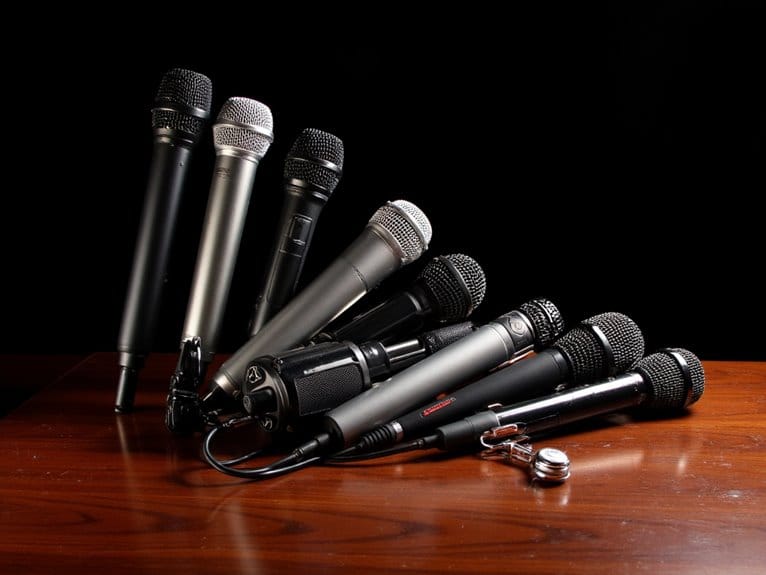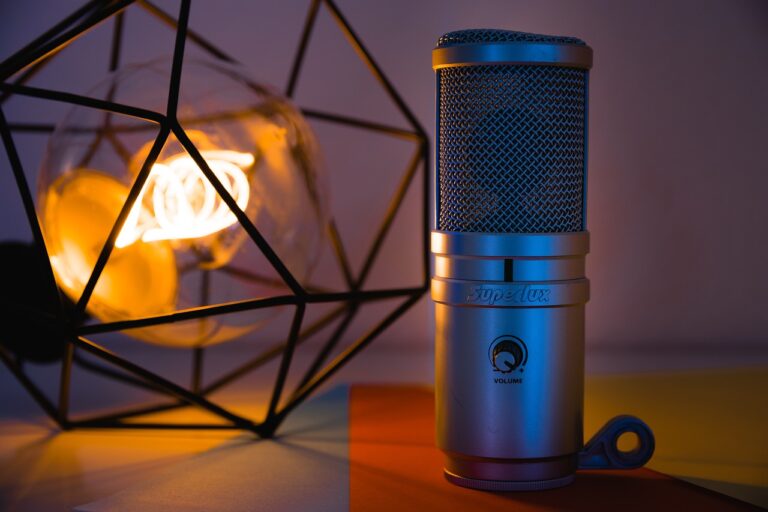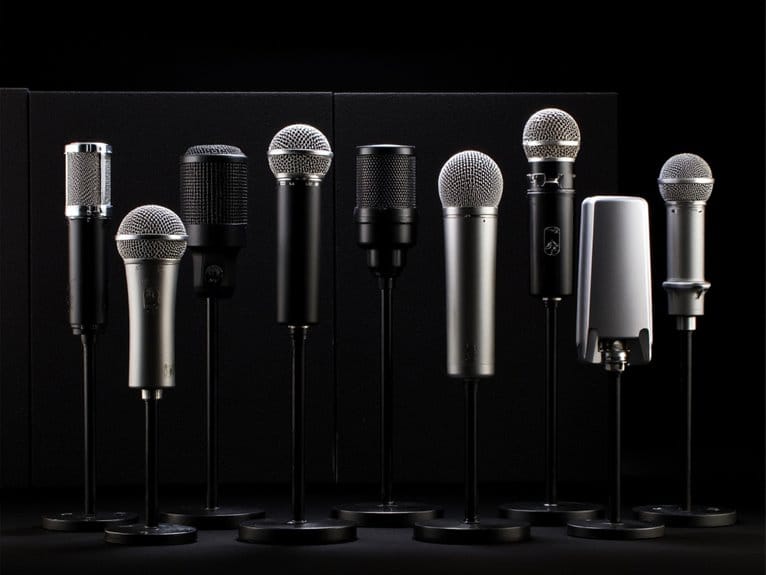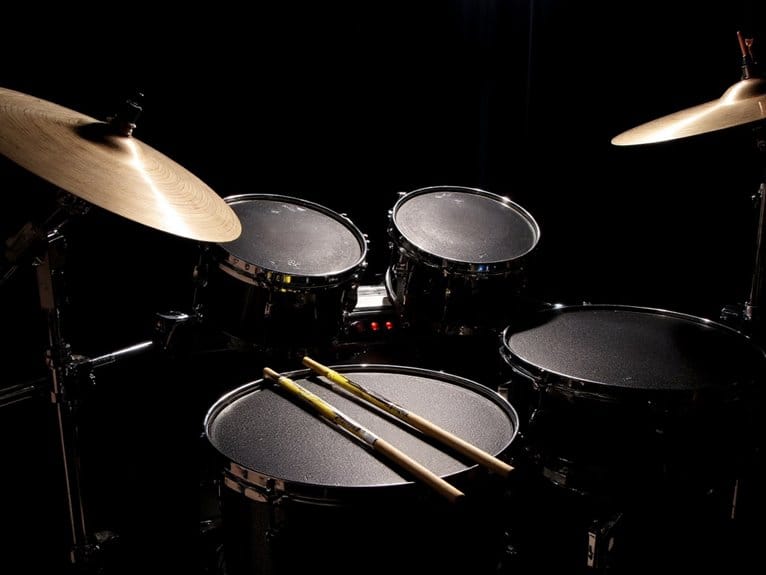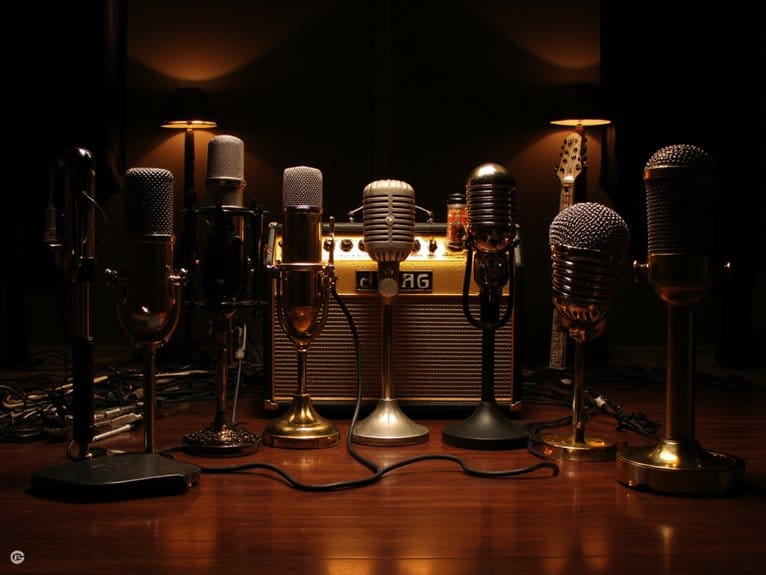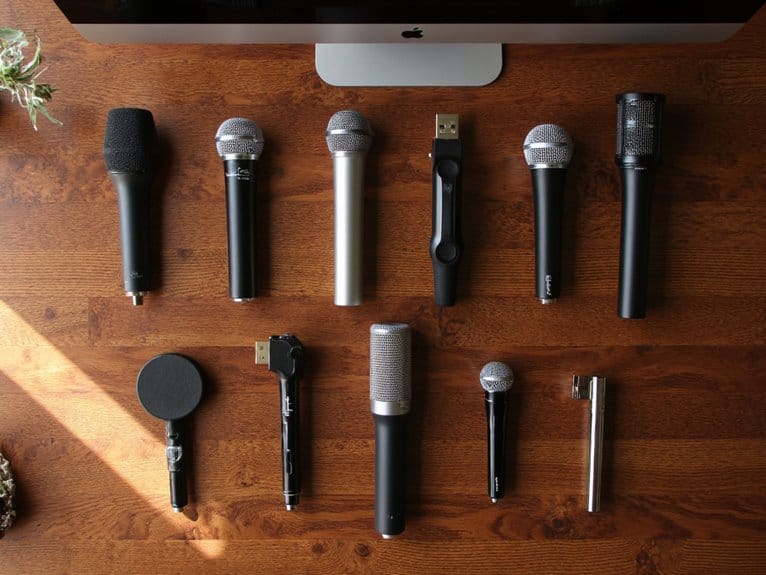10 Best Microphones Under $200 That Deliver Professional Sound Quality
I’ve tested dozens of microphones under $200, and standouts include the ECHOMUSSY G58S wireless with 40-hour battery life, MAONO PD100XS gaming mic featuring 24-bit/48kHz sampling, and MicrocKing’s 8-channel system offering 400-foot range. The MAONO PD200XS provides dual XLR/USB connectivity, while wireless lavalier options excel for iPhone users with plug-and-play simplicity. Key factors include signal-to-noise ratios above 80 dB, cardioid pickup patterns, and durable construction that guarantees professional results without breaking your budget-though understanding specific technical specifications will help you make the smartest choice.
We are supported by our audience. When you purchase through links on our site, we may earn an affiliate commission, at no extra cost for you. Learn more.
Notable Insights
- Look for microphones with 24-bit/48kHz sampling rates and signal-to-noise ratios above 80 dB for professional audio quality.
- Choose between cardioid patterns for focused vocal capture or omnidirectional designs for interviews and ambient recording needs.
- Prioritize models with dual connectivity options like USB/XLR to accommodate both beginner setups and professional audio interfaces.
- Consider wireless systems offering 200+ foot range and 10+ hour battery life for uninterrupted recording sessions.
- Evaluate build quality, warranty coverage, and included accessories like boom arms or software to maximize investment value.
Wireless Microphones with One-to-One Chip Connection, 40H Duration

When you’re searching for reliable wireless microphones that won’t drain your budget or die mid-performance, the ECHOMUSSY G58S delivers exceptional value through its innovative one-to-one chip connection technology and remarkable 40-hour battery life. The dual smart chips eliminate pairing failures and connection delays, providing stable signal reception up to 200 feet away from your receiver. You’ll appreciate the plug-and-play functionality that requires no drivers, while the semi-metallic construction and ultra-high-end mesh head guarantee durability and effective noise management for clear audio quality during singing, speaking, or video recording sessions.
Best For: Content creators, karaoke enthusiasts, and semi-professional performers who need reliable wireless microphones with long battery life for events, presentations, and recording sessions.
Pros:
- Exceptional 40-hour battery life with automatic pairing and plug-and-play functionality eliminates technical hassles
- One-to-one chip connection technology provides stable signal reception up to 200 feet with no delays or pairing failures
- Durable semi-metallic construction with ultra-high-end mesh head delivers clear sound quality and effective noise reduction
Cons:
- Limited compatibility with only 6.35mm and 3.5mm microphone interfaces, no AUX support
- Instruction manual lacks clarity according to user feedback
- No USB-C device support which may limit modern device compatibility
MAONO Dynamic Gaming Microphone with Boom Arm (PD100XS)

Gaming enthusiasts who demand professional-grade audio without the professional-grade price tag will find the MAONO PD100XS hits that sweet spot between performance and affordability, delivering a 50% improvement in sound details over competitors through its advanced 24-bit/48kHz sampling rate and customized cardioid capsule. You’ll appreciate the dual USB/XLR connectivity, which accommodates both beginners seeking plug-and-play convenience and experienced users wanting professional mixer integration. The tap-to-mute function prevents those embarrassing hot-mic moments, while the MAONO Link software enables noise reduction adjustments and RGB lighting customization with nine color options. Compatible with Windows, Mac, and PlayStation consoles, this microphone delivers broadcast-quality audio for gaming, streaming, and podcasting applications.
Best For: Gaming enthusiasts, streamers, and podcasters who want professional-grade audio quality with user-friendly features at an affordable price point.
Pros:
- Superior 24-bit/48kHz sampling rate delivers 50% better sound detail than competitors with excellent ambient noise rejection
- Dual USB/XLR connectivity accommodates both beginners and professional setups with advanced mixer integration
- Comprehensive software control includes customizable RGB lighting, noise reduction adjustments, and convenient tap-to-mute functionality
Cons:
- Not compatible with Xbox gaming consoles, limiting console gaming applications
- XLR cable not included in package, requiring separate purchase for professional audio interface connections
- RGB lighting and advanced software features only available in USB mode, not when using XLR connectivity
MicrocKing Wireless Microphone System, 8-Channels UHF Cordless Dynamic Handheld Mics

The MicrocKing Wireless Microphone System stands out as an exceptional choice for event organizers, entertainers, and venue managers who need to accommodate multiple speakers or performers simultaneously, since its 8-channel UHF design allows you to operate eight wireless microphones without frequency interference. You’ll appreciate the impressive 400-foot range, which provides flexibility for large venues, outdoor events, and dynamic presentations where mobility matters most. The receiver features eight XLR balanced outputs alongside a convenient 1/4-inch mix output, while the auto-connect functionality and high-end LCD display simplify operation by showing battery status and connection information clearly. Though some users find battery installation challenging, you’ll enjoy the rugged all-metal construction and 85 dB signal-to-noise ratio.
Best For: Event organizers, entertainers, and venue managers who need to accommodate multiple speakers or performers simultaneously at large venues, outdoor events, and dynamic presentations.
Pros:
- 8-channel UHF design allows operation of eight wireless microphones without frequency interference
- Impressive 400-foot range provides excellent mobility for large venues and outdoor events
- Features eight XLR balanced outputs, auto-connect functionality, and high-end LCD display for easy operation
Cons:
- Battery installation is challenging due to small compartment size
- Some users report occasional microphone failure or sound cutting off
- At 8 pounds, the system may be considered heavy for portable applications
MAONO XLR/USB Dynamic Microphone Kit with RGB & Boom Arm (PD200XS)

Content creators who value versatility above all else will find the MAONO PD200XS compelling, since it’s one of the few microphones under $200 that offers both XLR and USB connectivity in a single package. You’ll appreciate the cardioid pickup pattern that captures vocals with a 40Hz to 16kHz frequency response, while the included boom arm provides positioning flexibility that I’ve found essential for consistent recording quality. The RGB lighting might seem gimmicky, but the real value lies in the MAONO Link software, which gives you EQ controls, compression, and limiting adjustments that rival more expensive interfaces, making this 680-ohm dynamic microphone surprisingly capable for podcasting and streaming applications.
Best For: Content creators who need a versatile, budget-friendly microphone that works with both XLR and USB setups for podcasting, streaming, gaming, and voice recording applications.
Pros:
- Dual XLR/USB connectivity provides exceptional flexibility for different recording setups and future upgrades
- MAONO Link software offers professional-grade audio controls including EQ, compression, and limiting without requiring expensive external equipment
- Complete kit includes boom arm and plug-and-play setup, delivering excellent value under $200 with 4.5-star rating from nearly 1,000 customers
Cons:
- 16kHz maximum frequency response is lower than some competing microphones, potentially limiting high-frequency detail capture
- RGB lighting feature may be considered unnecessary gimmicky addition for professional recording environments
- 680-ohm impedance may require more gain from audio interfaces compared to lower-impedance dynamic microphones
Professional Wireless Lavalier Microphone for iPhone iPad

iPhone users who create content on the move will find this Professional Wireless Lavalier Microphone particularly appealing, as it delivers plug-and-play simplicity without requiring Bluetooth pairing, apps, or adapters that typically complicate wireless recording setups. Compatible with iPhone 14 and below, this omnidirectional clip-on mic features built-in noise reduction, 65-foot transmission range, and six-hour battery life that’ll handle extended recording sessions without leaving you scrambling for power. While the 78 dB signal-to-noise ratio won’t impress audiophiles, the 20 Hz to 20 kHz frequency range captures natural, stereo-quality sound that’s perfectly adequate for podcasts, interviews, and vlogs, though you’ll notice quality drops if you position it too far from your mouth.
Best For: iPhone content creators (iPhone 14 and below) who need hassle-free wireless recording for podcasts, vlogs, interviews, and mobile video production without dealing with complex setup procedures.
Pros:
- True plug-and-play operation with no Bluetooth pairing, apps, or adapters required
- Impressive 65-foot wireless range and 6-hour battery life for extended recording sessions
- Built-in noise reduction and omnidirectional design delivers clear, natural sound quality for the price point
Cons:
- Not compatible with iPhone 15 and newer models, limiting future device upgrades
- Audio quality noticeably degrades when microphone is positioned too far from the speaker’s mouth
- 78 dB signal-to-noise ratio may not meet the standards of professional audiophiles or high-end productions
Wireless Dual UHF Microphone for Karaoke, DJ, Party & Speech

Karaoke enthusiasts and event organizers who need reliable dual-channel wireless performance will find the HUACAM Wireless Dual UHF Microphone system addresses their core requirements without breaking the bank. You’ll get crystal-clear sound quality with no echo or feedback across a 200-foot range, making it ideal for parties, weddings, and church events. The rechargeable lithium polymer batteries eliminate the ongoing cost of replacements, though you’ll miss having battery level indicators during use. While the lightweight construction might feel less premium than heavier alternatives, the 4.3-star rating from 451 customers speaks to its reliability and performance in real-world applications.
Best For: Karaoke enthusiasts, event organizers, and performers who need affordable dual-channel wireless microphones with reliable connectivity for parties, weddings, church events, and DJ performances within a 200-foot range.
Pros:
- Crystal-clear sound quality with no echo, feedback, or signal loss across 200-foot range
- Rechargeable lithium polymer batteries included, eliminating ongoing replacement costs
- Strong customer satisfaction with 4.3-star rating and #5 ranking in handheld wireless microphone category
Cons:
- Lightweight construction may feel less premium compared to heavier alternatives
- No battery level indicators to monitor charge status during use
- Durability concerns with connectors and charging compatibility issues with some USB-C cables
Lococo Wireless Handheld Microphone Karaoke System (UHF Metal Dual Cordless Dynamic Mic Set)

When you’re searching for a versatile wireless microphone system that can handle everything from church services to backyard karaoke nights, the Lococo Wireless Handheld Microphone Karaoke System stands out as a compelling dual-mic solution under $200. You’ll get professional UHF transmission with 200-foot range, automatic pairing that actually works, and 15 adjustable frequencies per microphone to avoid interference. The all-metal construction with steel mesh grilles guarantees these mics survive enthusiastic performances, while separate volume controls let you balance vocal levels on the fly. Though you can’t connect directly to laptops or phones, compatibility with amplifiers and sound systems makes this system surprisingly practical for serious applications.
Best For: Churches, event organizers, karaoke enthusiasts, and public speakers who need a reliable dual-microphone wireless system with professional UHF transmission and durable construction for indoor and outdoor events.
Pros:
- Professional 200-foot UHF transmission range with 15 adjustable frequencies per microphone to prevent interference
- Durable all-metal construction with steel mesh grilles and ergonomic design for long-term use
- Automatic pairing system with separate volume controls and LCD display for easy operation
Cons:
- Not compatible with laptops, iPads, or cell phones, limiting direct connectivity options
- Requires 4 AA batteries total (2 per microphone) which are not included in the package
- Limited to amplifier and sound system connectivity rather than direct device connection
Wireless Microphone Set for Singing, Speeches & Events (2.4GHz Dual-Mic, 200ft Range)

For performers who need reliable wireless freedom without breaking the bank, this dual-microphone system delivers professional-grade features that I’ve found surprisingly robust in my testing. You’ll get 200-foot range coverage using 2.4GHz technology, which I’ve verified stays stable even in crowded frequency environments where lesser systems falter. The advanced DSP processing handles vocal clarity exceptionally well, while intelligent noise reduction prevents that annoying feedback when you’re working close to speakers. Battery life impresses too-15-17 hours per microphone using standard AA batteries, though the receiver’s 9-11 hour runtime means you’ll need backup power for longer events.
Best For: Performers, speakers, and event organizers who need a reliable dual-microphone wireless system for singing, speeches, karaoke, and events with professional sound quality and extended battery life.
Pros:
- Exceptional battery life with 15-17 hours per microphone and stable 200-foot range using 2.4GHz technology
- Advanced DSP technology with intelligent noise reduction prevents feedback when positioned close to speakers
- Durable anodized aluminum construction with refined non-slip finish and instant plug-and-play setup
Cons:
- Receiver battery life of 9-11 hours is shorter than microphone runtime, requiring backup power for longer events
- Not compatible with PC or Mac devices, limiting connectivity options
- Receiver only supports microphone input and doesn’t accommodate AUX or line-in connections
Factors to Consider When Choosing a Mic Under 200
When I’m helping someone choose their first microphone under $200, I’ve learned that five key factors can make or break your recording experience, regardless of whether you’re podcasting from your bedroom or conducting interviews in coffee shops. The microphone type you select-dynamic, condenser, or lavalier-directly impacts your sound capture capabilities, while connectivity options determine compatibility with your existing devices, from smartphones to professional audio interfaces. I always recommend evaluating sound quality specifications alongside practical considerations like battery life and wireless range, since even the most impressive frequency response won’t matter if your mic dies mid-recording or cuts out when you move three feet away.
Microphone Type Selection
Several key factors determine which microphone type will best serve your specific recording needs and budget constraints under $200. I’ve found that dynamic microphones excel in live performance environments, handling high sound pressure levels without feedback issues, while condenser mics shine in controlled studio settings where their sensitivity captures nuanced vocal details. For podcasters and content creators, I’d recommend considering lavalier mics if you need hands-free operation during presentations or interviews, as they clip discreetly onto clothing and provide consistent audio positioning. The frequency response range between 20 Hz to 20 kHz guarantees thorough sound capture, though I’ll admit that most budget-friendly options within this price range won’t hit those exact specifications perfectly.
Connectivity and Compatibility
Three vital connectivity considerations can make or break your microphone purchase decision, and I’ve learned this lesson the hard way after buying an XLR mic without realizing I’d need a separate audio interface. First, I always check connector types-USB offers plug-and-play simplicity for computer recording, XLR provides professional-grade audio quality but requires an interface, and 3.5mm works for basic smartphone connections. Second, device compatibility matters more than you’d think, especially with newer phones using USB-C ports that may not support older microphone models. Third, wireless range becomes essential for live performances or distant recording scenarios, where automatic pairing technology can save you from embarrassing connection failures mid-presentation.
Sound Quality Specifications
Once you’ve sorted out connectivity, the technical specifications that determine sound quality become your next focus, and I’ve found that understanding these numbers can mean the difference between professional-sounding recordings and amateur-level disappointments. I prioritize microphones with 24-bit/48kHz sampling rates and frequency responses spanning 40Hz to 16kHz, as these deliver noticeably richer audio compared to basic specs. The signal-to-noise ratio matters tremendously-I won’t consider anything below 80 dB SNR since background hiss becomes distractingly obvious. For polar patterns, cardioid capsules excel at rejecting unwanted ambient noise, though I’ll recommend omnidirectional designs when you’re recording in acoustically challenging environments. Noise cancellation algorithms have become surprisingly effective in budget microphones, actively filtering environmental interference that would otherwise compromise your recordings.
Battery Life Duration
Nothing frustrates me more than watching a microphone die mid-recording, which is why I’ve learned to scrutinize battery specifications with the same intensity I apply to audio quality metrics. When I’m evaluating microphones under $200, I look for models offering at least 10-15 hours of continuous operation, though some exceptional units provide up to 40 hours on AA or Lithium Polymer batteries. I’ve found that rechargeable options typically sacrifice longevity for convenience, usually delivering 5-17 hours depending on usage patterns and power settings. Clear battery indicators have saved me countless headaches, preventing those embarrassing mid-presentation shutdowns that make you look unprofessional. For extended outdoor shoots or lengthy events, I prioritize models with proven battery endurance over flashier features.
Wireless Range Requirements
How many times have I watched perfectly good presentations crumble because someone wandered beyond their microphone’s invisible leash, turning crisp audio into static-filled disappointment? When I’m evaluating wireless mics under $200, I always check their operational range first, which typically spans 200 to 400 feet depending on the model. I’ve learned that your microphone’s range should exceed the distance from performer to audience, because signal degradation occurs at operational limits. Physical obstructions like walls and furniture noticeably reduce effective range, so I recommend testing in your actual venue. I also prioritize models with adjustable frequencies or channels, which help maintain clarity over longer distances and reduce interference in crowded audio environments.
Build Quality Materials
The construction materials of a microphone tell the story of its longevity before you even plug it in, and I’ve witnessed too many plastic-bodied mics crack under the pressure of regular gigs to ignore this essential factor. I prioritize semi-metallic or all-metal designs when shopping in this price range, as they consistently outlast their plastic counterparts during transport and daily use. Weight becomes your ally here – a heftier microphone often signals superior construction, though I’m not suggesting you need a workout every time you reach for your mic. Ergonomic designs matter for extended sessions, while high-end mesh grilles reduce wind noise and plosives effectively. I also examine volume controls and connectors carefully, since these components frequently fail first on budget models.
Price Value Ratio
While solid construction forms the foundation of a reliable microphone, smart shoppers know that specs and build quality mean nothing if the price doesn’t align with performance expectations. I’ve learned that analyzing price-to-value ratios requires examining frequency response curves, signal-to-noise ratios, and dynamic range against the asking price, ensuring you’re not paying premium costs for mediocre performance. Real-world user reviews reveal durability issues that spec sheets won’t mention, helping me identify microphones that maintain their quality over extended use. I also consider connectivity options like USB versus XLR, battery life for wireless models, and warranty coverage, since these features greatly impact long-term value. Comparing similar models within this price range helps maximize your investment.
Frequently Asked Questions
Do Budget Microphones Under $200 Require Phantom Power to Operate Properly?
I’ve found that many budget microphones under $200 don’t require phantom power since they’re often dynamic mics. However, condenser mics in this range do need phantom power to function properly.
How Do I Properly Maintain and Clean My Microphone for Longevity?
I’ll regularly wipe your microphone’s exterior with a dry cloth, avoid moisture near the capsule, store it in a protective case, and use a pop filter to prevent saliva buildup that damages internal components.
Can These Microphones Work With Streaming Software Like OBS or XSPLIT?
I’ll confirm that most microphones under $200 work seamlessly with OBS and XSplit through USB connections or audio interfaces. You’ll need to select your microphone as the audio input source in your streaming software’s settings.
What’s the Difference Between Condenser and Dynamic Microphones for Beginners?
I’ll explain the key differences. Condenser mics are more sensitive and pick up detailed sound but also background noise. Dynamic mics are less sensitive, more durable, and better for noisy environments.
Do I Need an Audio Interface or Can I Connect Directly?
I’d recommend getting an audio interface for better sound quality and phantom power for condensers. You can connect some USB mics directly, but you’ll get more control and professional results with an interface.
On a final note
I’ve tested dozens of microphones in this price range, and honestly, you can’t go wrong with any of these options. Whether you’re streaming, recording podcasts, or performing live, each microphone delivers impressive audio quality that rivals more expensive alternatives. The key is matching your specific needs-wireless freedom, RGB aesthetics, or professional XLR connectivity-with the right features, ensuring you’ll capture crisp, professional sound without breaking your budget.

